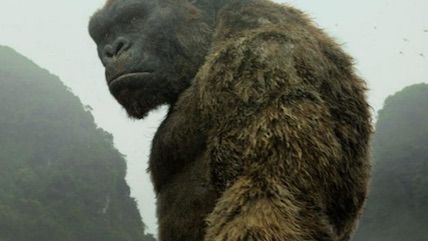Movie Review: Kong: Skull Island
Tom Hiddleston and John C. Reilly join the celebrated ape for yet another CGI origin story.


Good grief, Kong again? Let's recap. 1933: The big ape makes his stop-motion debut. 1962: Side trip to Tokyo for some Mixed Monster Arts with Godzilla. 1976: Some Christmas Kong with newcomer Jessica Lange. 2005: Peter Jackson takes a fanboy whack at the never-ending franchise. There was also a Kong stage musical a few years back, but that was in Australia and let's stay focused.
Anyone who's seen all or even a few of the previous Kong movies is unlikely to be enthused anew by the latest one, Kong: Skull Island, a second feature by indie director Jordan Vogt-Roberts, who's been given an estimated $190-million to go through all the old motions once again. The movie has the usual deep monster bench—along with Kong himself, we make the acquaintance of assorted stegosaurs, brontosaurs, dive-bombing pteranodons, serpenty elasmosaurs and big frickin' tree spiders. Giant ants are also promised at one point, but never arrive. Which is too bad—there can never be too many monsters.
Humans are another matter. There are too many of them here, and some of them waste too much of our time putting in meaningless appearances—we can't keep them straight. But this isn't a movie about humans. It's a movie about computer animation, which, as always, is "state of the art" (for the moment) and, as is so often the case, both undeniably impressive and a little boring.
The story, set in 1973 this time, at the calamitous end of the Vietnam War, is familiar. A crackpot scientist (well, he's some kind of science guy) named Randa (John Goodman) is all jumped up about a mysterious island in the South Pacific—"a place where God didn't finish creation." The island has remained uncharted because it's surrounded by a "perpetual storm system"—although it's not so perpetual that Randa, after securing an infusion of taxpayer money from a soft-touch congressman, can't punch through it in a squad of helicopters on loan from the U.S. military. Randa has assembled a team that includes, among too many others, a former British special forces "tracker" named Conrad (Tom Hiddleston) and a number of U.S. military personnel (Toby Kebbell, Shea Wigham), including a cantankerous colonel (Samuel L. Jackson) who's angry about the lost war and still in the mood to kick some Third World butt, human or otherwise. Note the parable taking shape here.
There are also two women in Randa's crew, one for little reason, one for even less. Brie Larson is supposed to be an antiwar combat photographer named Weaver. Her duties here basically boil down to sharing one chaste hug with Hiddleston (it's the movie's sole breath of romance) and putting in the traditional appearance reclining in Kong's leathery palm. The other female presence is Chinese actress Jing Tian (The Great Wall), whose character is basically a cute science chick and whose name could be helpful in selling the movie in a certain very large foreign film market. (Jing's an agreeable performer, judging by what little we're shown here, but it doesn't seem she's been hired for her acting talent.)
After an overlong introductory section in which we see Randa gathering his crew and setting off in the helicopters, the story finally arrives on Skull Island. Now we get the iconic shot of Kong rising up to flick away the choppers surrounding him, and one unlucky airman tumbling down into his fang-filled mouth. There's also the giant-spider attack—which really is pretty great—and a scene in which Kong defeats and slurps down a giant squid as if he were auditioning for an Oldboy remake.
Virtually everything in the film that's worth watching is computer-generated—how excited you get about it may depend on how long you've been watching expensive CGI erupting onscreen. The picture's best non-digital attraction is John C. Reilly, who plays a twinkly, long-marooned World War II airman named Marlow, and who walks away with most of the movie. Marlow is a name out of Joseph Conrad's Heart of Darkness, the book that was the basis of Francis Ford Coppola's Apocalypse Now, and that film is visually referenced throughout this one—for example, in the spooky jungle compound and painted natives, the napalm inferno, the chopper-borne reel-to-reel tape deck blasting out period rock hits. (Listen up for the usual nods to Jefferson Airplane, Creedence Clearwater Revival, and so forth.)
The constant allusions to Coppola's film, and to its depiction of marauding Western imperialism, are kind of endearing: how nice to know the filmmakers' hearts are in the right place, even if the place is 38 years away. However, the director and his army-size team know that the only things we really care about—the only things we want to see and hear—are Kong's chest-thumping bellow and the mincemeat he makes out of multiple fellow monsters. One has to admit that some of the lizard-stomping action here is pretty terrific. But the scariest moment in the movie comes at the end of the credits, in the form of a promise that struck me as more of a threat. I'll say no more.


Show Comments (20)